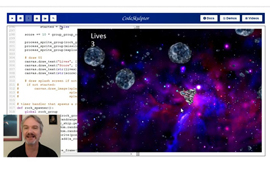MOOCs: Lessons from the front lines
Rice University’s first “massive open online course,” or MOOC — an eight-week computer programming class on the website Coursera — drew more than 80,000 registered students and forever changed the way its instructors view classroom teaching.
“I will never lecture in a classroom again,” course co-instructor Scott Rixner said Dec. 7 at the Ken Kennedy Institute for Information Technology’s (K2I) monthly member luncheon. “This is how I will teach in the future, whether I’m teaching for 80,000 people online or 20 people in a Rice classroom.”
Rixner, associate professor of computer science, who has taught at Rice since 2000, is one of four co-instructors for the MOOC, An Introduction to Interactive Programming in Python. The course launched Oct. 15 with 67,000 registered students and drew several thousand more before registration was cut off in mid-November.

Rice computer scientists (from left) Scott Rixner, Stephen Wong, Joe Warren and John Greiner are wrapping up Rice's first massive open online course, or MOOC, this week. Here, they demonstrate "Rock-paper-scissors-lizard-Spock," the first game that students programmed in the class.
Rixner said he and co-instructors Joe Warren, professor and chair of the Department of Computer Science, and Stephen Wong and John Greiner, both lecturers in computer science, decided to pilot the course with Rice students in COMP 160 before teaching the MOOC.
“This was the first lesson we learned,” Rixner said. “You should always test the material on a small class first. We learned what would and would not work before we did this in front of tens of thousands of people.”
Rixner said an equally valuable lesson was how the MOOC format improved the classroom experience at Rice — even though the MOOC material made up only a portion of the COMP 160 curriculum. For the MOOC, students’ weekly assignments are to watch six to eight videos, take two quizzes and complete one programming project. For the first eight weeks of COMP 160, Rice students watched the MOOC videos and took the quizzes before coming to class.
“By the time they got to class, they knew the material and were ready to discuss it,” he said. “A lot more learning went on the classroom than if I had been lecturing. I am not willing to give that up. That’s why I am committed to teaching this way from now on.”
Rixner said he and his co-instructors experienced the same sort of drop in participation that is often reported with MOOCs. For example, 47,000 students watched the course’s first video lecture, and by week seven that number had fallen to about 10,000.
“Another thing we learned was that attrition appears to be a constant,” Rixner said. “Attrition was really high at the beginning, and then tapered off, but it never actually stopped. As a result, we had fewer students watching the videos and turning in the assignments each week. For us, the takeaway is that shorter courses are probably better for the MOOC format.”
Rixner said preparing and teaching the course took almost all of his time for the past six months.
“That’s not an exaggeration,” he told the K2I members. “We counted our hours at one point, and I know there was one week when Joe spent 83 hours on this and I spent 75.”
But Rixner is quick to point out that Rice faculty won’t have to spend that kind of time developing a course, in part because he, Warren, Greiner and Wong can pass along some of the lessons they learned through trial and error.
“Making videos is by far the most time-consuming part of this,” Rixner said. “It is much more difficult to make an effective 10-minute video than it is to prepare for a 50-minute lecture.”

Course co-instructor Joe Warren demonstrates CodeSkulptor, a new tool Rixner created to teach the MOOC. CodeSkulptor has been viewed more than 2.7 million times and is already being used by other universities and companies.
Rixner, Warren, Greiner and Wong prepared more than 50 short video tutorials for the course. “It is important to get the videos right because students will let you know if you make a mistake,” Rixner said. He said the potential impact of the videos is another reason to film and re-film them time and again until they are perfect.
“This is about Rice’s brand,” Rixner said. “In one 10-minute video, I may influence what more people think of Rice than I could in 20 years of classroom teaching.”
The comments Rixner and Warren have received on the course forum bear that out. Several hundred students have weighed in, mostly with positive comments, like:
- To be completely honest, this is the BEST online class I’ve ever taken, including ones from my college that I was paying for.
- As a European, I hadn’t heard of Rice University before, but this course has given me a really good impression of Rice.
- You have proven that online education can be a superior mode of learning when the right format is used along with world-class professors. … If I ever meet you guys in person I will be asking for your autograph.
- Do they really teach their classes like they do in Coursera? If yes, I would love to be a student in the university where they teach!
- This class has been one of the best academic experiences of my life.
- This class makes me wish I had gone to Rice U. when I had started college and pursued a degree in computer science.
- You made the class so interesting and challenging that my 12-year-old, who is very hard to impress, has been spending time coding on his own free time (typically occupied by skateboarding ;))
Rixner said he has no regrets about teaching the course, and in spite of the time it took to prepare and teach, he said teaching the course not only made him a better teacher, it will also pay other dividends.
“CodeSkulptor, the Python development environment we created for the course, has over 2.7 million page views and is already in use outside of our course,” Rixner said. “This will provide numerous research opportunities exploring how students learn to program.”
More than 5,000 students have pre-enrolled for the next section of the course, which will be offered on Coursera in the spring.



Leave a Reply